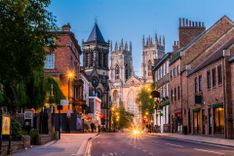Emerging from the bridge at Salmon Lane Lock, where the Regent’s Canal meets the Thames, Limehouse Waterside and Marina present a prosperous sight. Named for the fourteenth-century lime kilns once located here, Limehouse has been a significant port since Tudor times.
The next stage of this journey joins the Thames Path along the righthand side of the basin, where the Baroque Hawksmoor Church of St Anne is an unmissable sight. On reaching the river, you might want to stop for a spot of lunch in The Narrow — a Gordon Ramsay gastropub with a riverside setting.
Alternatively, for a more traditional pub experience, continue to Prospect Path. After passing converted warehouse buildings, and King Edward Memorial Park - with great views back to Canary Wharf along the way - you’ll reach Prospect of Whitby at Wapping Wall. Built in 1520, this is London’s oldest riverside inn and still oozes an old-time atmosphere.
8. Greenwich Park - Blackheath to Canary Wharf
This 5km walk takes you through two of London’s most distinctive green spaces, while also taking in a host of historical sights you’ll almost certainly want to stop off at.
Beginning at Blackheath, where Wat Tyler rallied the Peasants’ Revolt in June 1381, head along the path in the direction of Canary Wharf’s pyramid-capped peak, crossing Shooters Hill Road to reach the Blackheath Gate entry to Greenwich Park. Art-lovers will want to visit red-brick Ranger’s House: an elegant Georgian villa housing a collection of Dutch Old Masters and Renaissance bronzes.
Next up, head up to the Royal Greenwich Observatory to stand on the prime meridian line, and explore the museum, planetarium, and Sir Christopher Wren’s Flamsteed House, where the Astronomer Royals once live and worked. The views aren‘t half bad either.
En route to the Cutty Sark, it’s well worth detouring to Greenwich Market, and stopping off at the Old Royal Naval College (part of the Maritime Greenwich UNESCO World Heritage Site), with its spectacular painted hall, the National Maritime Museum and the stately seventeenth-century Queen’s House.

















